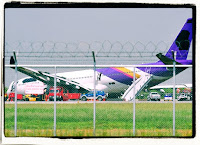Debranding: Why Painting Over Your Logo Isn't Enough
When a Thai Airways plane skidded off the runway after a landing gear failure last week the airline moved quickly to cover up their logo on the damaged aircraft. This is standard practice in the airline industry and, as a Thai Airways spokesperson explained to The Guardian, it is also required by the Star Alliance crisis communication guidelines.
Removing your corporate branding from a damaged aircraft or other asset seems a sensible thing to do. It will reduce the number of photos circulating that tie your brand to a negative event and -- specifically for airlines -- it is probably better for nervous flyers. But just painting over the logo with black paint is not the best way to go about it. Even after the black paint was hastily applied anyone familiar with the Thai Airways livery could immediately recognize it from the colors. This is the irony of effective branding. When it is well done people can recognize your product just by the colors, the shape or some other small design detail.
If you want to do it right you need to completely remove all the branding elements, and it is much better to cover everything with white paint, so that the aircraft just looks like it is unpainted, not that something has been covered up. Alitalia demonstrated this approach earlier this year when one of their ATRs skidded off the runway in a similar incident. Note how all of the recognizable colors are removed, not just the logo.
This is already a big improvement, but too much haste in removing the logo always leads to some negative coverage, like in Thai Airways staff cover up plane's logo after accident and Colpo di spray nella notte Cancellato il logo Alitalia. Even when the branding is removed effectively by doing it too quickly you give the impression that you are trying to hide something, and just encourage people to make before and after comparisons, which are worse than the original scene. Anyway, it doesn't matter how fast you do it because today everyone has a camera in their pocket so someone will capture a photo before the paint crew arrives-
A much better way to handle the problem is to remove the aircraft and then make the branding disappear gradually. British Airways did this very well following the incident at Heathrow in 2008 when a 777 was written off when it landed before the runway after a loss of thrust. The wreckage was moved to another part of the airport, behind a high fence, and the tail with the BA logo was removed to make it less visible. Later all the other branding was removed but at the same time the airframe was being cut up, so this looked like a normal part of the dissassembly process, not a coverup.
And while you are refining your crisis communication plans, another best practice to be aware of is to follow the crisis communication guidelines without talking about them. Everyone should have a crisis communication plan and be prepared to use it, but you undermine the effectiveness of the plan if you share the content with media.
Lectures, Workshops, Coaching and Writing
For lectures, workshops, coaching and writing about branding and other communication topics visit http://andrewhennigan.com, email conseil@andrewhennigan.com or call 0033 6 79 61 42 81 in France or 0046 730 894 475 in Sweden.
Removing your corporate branding from a damaged aircraft or other asset seems a sensible thing to do. It will reduce the number of photos circulating that tie your brand to a negative event and -- specifically for airlines -- it is probably better for nervous flyers. But just painting over the logo with black paint is not the best way to go about it. Even after the black paint was hastily applied anyone familiar with the Thai Airways livery could immediately recognize it from the colors. This is the irony of effective branding. When it is well done people can recognize your product just by the colors, the shape or some other small design detail.
If you want to do it right you need to completely remove all the branding elements, and it is much better to cover everything with white paint, so that the aircraft just looks like it is unpainted, not that something has been covered up. Alitalia demonstrated this approach earlier this year when one of their ATRs skidded off the runway in a similar incident. Note how all of the recognizable colors are removed, not just the logo.
 |
| Alitalia whites out corporate branding completely following an incident in Rome. |
A much better way to handle the problem is to remove the aircraft and then make the branding disappear gradually. British Airways did this very well following the incident at Heathrow in 2008 when a 777 was written off when it landed before the runway after a loss of thrust. The wreckage was moved to another part of the airport, behind a high fence, and the tail with the BA logo was removed to make it less visible. Later all the other branding was removed but at the same time the airframe was being cut up, so this looked like a normal part of the dissassembly process, not a coverup.
And while you are refining your crisis communication plans, another best practice to be aware of is to follow the crisis communication guidelines without talking about them. Everyone should have a crisis communication plan and be prepared to use it, but you undermine the effectiveness of the plan if you share the content with media.
Lectures, Workshops, Coaching and Writing
For lectures, workshops, coaching and writing about branding and other communication topics visit http://andrewhennigan.com, email conseil@andrewhennigan.com or call 0033 6 79 61 42 81 in France or 0046 730 894 475 in Sweden.



Comments